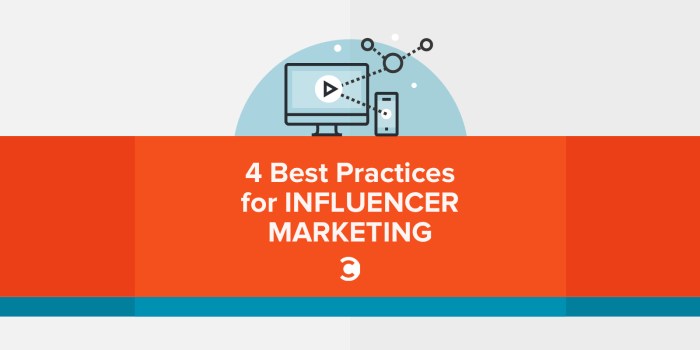Best Practices in Influencer Marketing takes center stage, inviting readers into a world of savvy strategies and impactful collaborations. Get ready to dive deep into the realm of digital influence!
In today’s digital age, influencer marketing has become a powerhouse in brand promotion. From selecting the right influencers to measuring ROI, this guide will equip you with the essential knowledge to excel in this dynamic field.
Introduction to Influencer Marketing
Influencer marketing is a strategic form of marketing that focuses on utilizing key individuals to promote a brand or product to a larger audience. In the digital age, where social media plays a significant role in consumer behavior, influencer marketing has become increasingly important for brands to reach and engage with their target market.Over the years, influencer marketing has evolved from traditional celebrity endorsements to collaborations with social media influencers, bloggers, and content creators.
These influencers have built a loyal following and credibility within their niche, making them valuable partners for brands looking to connect with their audience in a more authentic and relatable way.
Examples of Successful Influencer Marketing Campaigns
- The collaboration between fashion brand Revolve and influencers like Chiara Ferragni and Aimee Song, which helped the brand gain visibility and reach a younger demographic.
- The partnership between fitness company Gymshark and fitness influencers like Whitney Simmons and Nikki Blackketter, leading to increased brand awareness and sales within the fitness community.
- The campaign by cosmetic brand Glossier, working with beauty influencers to create user-generated content and reviews, resulting in a strong online presence and customer engagement.
Identifying the Right Influencers
Influencer marketing can be a powerful tool for brands to reach their target audience in a more authentic and engaging way. However, it is crucial to select influencers that align with your brand values to ensure a successful partnership.
The Importance of Aligning Brand Values
When choosing influencers, it is essential to consider whether their values and content align with your brand. This alignment helps maintain brand authenticity and credibility, making the partnership more impactful and genuine.
- Look for influencers who share similar values and beliefs as your brand.
- Ensure that the influencer’s content and messaging resonate with your target audience.
- Avoid partnerships with influencers whose values may contradict or damage your brand image.
Criteria for Choosing Influencers
In addition to brand values, it is important to consider the audience demographics and engagement of potential influencers.
- Review the influencer’s follower demographics to ensure they match your target audience.
- Assess the influencer’s engagement rate and audience interaction to gauge their influence and impact.
- Consider the influencer’s content quality, relevance, and authenticity to determine their suitability for your brand.
Research and Vetting Process
To effectively research and vet potential influencers, follow these tips:
- Conduct thorough research on the influencer’s background, past collaborations, and reputation.
- Engage with the influencer’s content to understand their tone, style, and messaging.
- Check for any red flags or controversies associated with the influencer that may harm your brand.
Crafting Effective Influencer Partnerships: Best Practices In Influencer Marketing

When it comes to crafting effective influencer partnerships, there are several key components that play a crucial role in the success of the collaboration.
Key Components of a Successful Influencer Partnership
- Authenticity: The influencer must genuinely connect with your brand and believe in the products or services being promoted.
- Relevance: It’s essential to choose influencers whose audience aligns with your target market to ensure maximum impact.
- Engagement: Look for influencers who have high engagement rates with their followers, indicating a strong connection and influence.
Negotiating Terms, Compensation, and Expectations
- Terms: Clearly Artikel the scope of work, deliverables, and timeline to avoid any misunderstandings later on.
- Compensation: Negotiate fair compensation based on the influencer’s reach, engagement, and the complexity of the campaign.
- Expectations: Set clear expectations regarding content quality, posting frequency, and any exclusivity requirements.
Setting Clear Goals and KPIs
Before launching an influencer campaign, it’s crucial to establish clear goals and key performance indicators (KPIs) to measure the success of the partnership.
Without defined metrics, it becomes challenging to evaluate the impact of the influencer collaboration accurately.
Content Creation and Collaboration

Creating engaging content with influencers is crucial for successful marketing campaigns. Authenticity and transparency play a significant role in building trust with the audience. Maximizing the impact of influencer-generated content across different platforms can help reach a wider audience and drive more engagement.
Best Practices for Creating Engaging Content
- Understand the target audience: Tailor the content to resonate with the followers of the influencer.
- Collaborate on content ideas: Work with influencers to develop creative and unique content that aligns with your brand.
- Utilize different formats: Experiment with videos, photos, stories, and other forms of content to keep the audience engaged.
- Include a call-to-action: Encourage the audience to take a specific action after engaging with the content.
Maintaining Authenticity and Transparency
- Disclose partnerships: Ensure that influencers clearly disclose their relationship with your brand to maintain transparency.
- Encourage honest reviews: Allow influencers to provide genuine feedback on products or services to maintain authenticity.
- Avoid over-editing: Let influencers maintain their unique voice and style in the content creation process.
Maximizing Impact Across Platforms
- Repurpose content: Adapt influencer-generated content for different platforms to maximize reach and engagement.
- Engage with the audience: Encourage interactions and discussions around the content to boost visibility.
- Analyze performance: Monitor the performance of influencer content across platforms and optimize strategies based on data insights.
Measuring Success and ROI
In influencer marketing, it’s crucial to track and measure the success of your campaigns to ensure you’re getting a return on investment (ROI).
Tracking Methods, Best Practices in Influencer Marketing
- Utilize tracking links with UTM parameters to monitor traffic and conversions from influencer posts.
- Implement unique discount codes or affiliate links to attribute sales back to specific influencers.
- Use social media analytics tools to track engagement metrics like likes, comments, shares, and reach.
Analyzing Metrics
- Engagement: Measure likes, comments, shares, and overall interaction with influencer content to gauge audience interest.
- Reach: Evaluate the number of people who have seen the influencer’s posts to understand the campaign’s exposure.
- Conversions: Track the number of sales or leads generated from influencer promotions to assess the campaign’s effectiveness.
Tools for Evaluating ROI
- Socialbakers: Provides comprehensive social media analytics to track influencer performance and ROI.
- Google Analytics: Allows you to monitor website traffic and conversions from influencer-driven campaigns.
- Impact: Offers influencer marketing software with advanced tracking and measurement capabilities.
